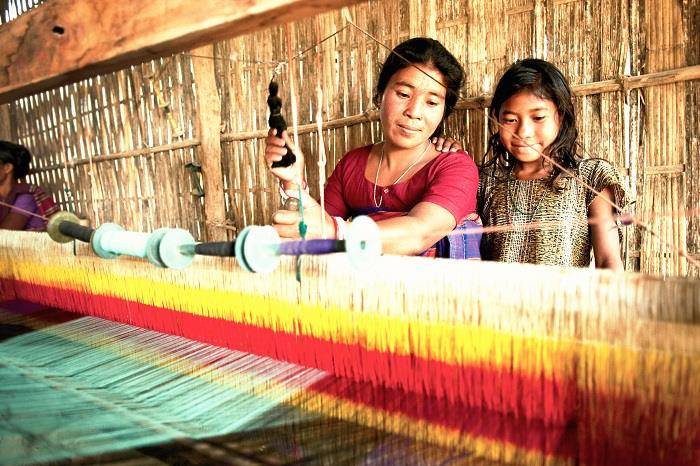For ages, India has glorified & worshipped its teachers and gurus. Our culture teaches us to place Guru at the highest pedestal even above parents and the Lord. And Indian Handloom weavers and artisans are one such beautiful example of the Guru-Shishya Parampara. Unnati Silks elaborates on how Handlooms have survived, evolved and prospered over the centuries with one core principle at the heart of it – To Have Unflinching Faith in your Guru.
Dr. S. RadhaKrishnan, second President of India, initiated a healthy observance of celebrating his birthday on September 5th as Teacher’s Day that continues since. It is an acknowledgment of the immense contribution that teachers make in shaping our lives and writing our destinies. When the former President, a teacher himself, started this practice, he felt that the institution called ‘teacher’ represented a pillar of society, imparting a knowledge extending far beyond the curriculum. Therefore at least a day be observed when the grateful student could acknowledge with gratitude the tremendous impact that a teacher has made in his or her life and also contributed significantly to the core values that he or she harbors.
The Guru Shishya Parampara – shiningly displayed in the handloom industry
The handloom industry in India is as traditional and rooted as the concept teacher-student relationship and existing from age old times, though it may not be so obvious and prevalent in urban society of today. But the age-old Guru Shishya tradition still dominates a majority of many a rural pocket of the land wherein the master weaver or craftsman, imparts the knowledge of his craft, explains the nuances and moulds those working under him, to not only learn the craft for seeking a decent livelihood but also become inherently capable of carrying on the tradition and imparting to the next generation.
Says Mr. Pranoy Dasgupta, the proud owner of a boutique known for its exclusive interest in handlooms, “It’s amazing how the knowledge of the craft or ‘art’ is imparted. No formal pedagogy, fixed curriculum, written notes to study or hand-held guidance to perfect the know-how. Yet the ‘literally illiterate’ student gets going in no time at all by sheer obedience and observation.”
It is a shining example of how the dedicated teacher explains all that he knows by example, making the eager & devoted student focused and absorbing to get the feel of the craft and the skill of the teacher. “In this industry, where you can perceive the enormous variety, each pocket has its local flavor or ethos, a difference in style, a nuance that is known only to the Master weaver and the students under his wing. So the student in time becomes Master to those learning from him and the tradition continues.”
Mr. Devender Ladha, CEO & founder of Unnati Silks, a family enterprise with global operations since 1980 & exclusively dealing with almost all varieties of fabrics like handloom sarees, handloom salwar kameez, printed kurta & kurti, Indo western apparel etc. offers some deep insights from the passion that has kept him with handlooms from the beginning and an association with the weaving industry that spells his deep love for the craft and craftsmanship.
“The humble weaver mostly exists in the rural pockets and far-flung places that constitute a considerable chunk of Free India. He has neither had formal education nor has he imbibed knowledge of the weaving process in a systematic classroom format. He has learnt the art and craft of the weaving process from his father or some elder and devoted himself to his task of practicing what he has learnt to become in time a Master himself.”
“There is no written instruction that he can read and follow since others before him have not given him a “manual of instructions” because illiteracy was rampant and even later writing materials still constituted a luxury. He does not have the luxury to experiment & learn since materials are scarce and costly. Yet what he learns by rote and spins from memory is a fabric that has always remained baffling for the flawless weave, extraordinary creativit, and amazing appeal.”
Perhaps, one of the most popular and widely sought after artistic crafts since traditional times, adorning Indian ethnic fabrics with its unique and classy outcomes, is the Ikat process.
Ratanlal Kiromal, a close friend of Mr. Ladha and who shares similar sentiment regarding handlooms adds, “If one were to pick the extraordinary fabric weave – the ikat, found in the fabrics woven at Pochampally in Telangana, Sambalpur in Odisha and Rajkot in Gujarat, that forms a design within the weave from complicated calculations, seamless inclusions, resulting in uniquely extraordinary patterns, one could only marvel at the transfer of knowhow and sheer use of brain power in the whole effort.”
“A shining display of the Guru Shishya Parampara, the ikat handlooms have ‘wowed’ the fashion industry to such an extent that it has not stopped its use in designer clothing till today. Yet the three Ikat flavors are quite different, distinguishable and individualistic.”
Other shining examples of handlooms
Practiced with different styles in two distinct places in Andhra Pradesh, Kalamkari from the time it has been displayed before the world, has captivated, fascinated and enamored all those who have come in contact with it.
The colors used, the choice of themes, the sharpness of the lines, the intricate detailing and its applicability over a wide range of fabrics have all contributed to its popularity in the market. The finesse and artistry came from mere verbal instructions over time.
Says Mr. Roy Chowdhury, once in Bangladesh, now a permanent resident of Odisha, a die-hard fan of Bengal textiles, “If I recall my younger days, I was literally breathing textiles in the back lanes of East Bengal, I recall the dinghy habitats of the handloom workers. In cramped spaces and dirty surroundings one can hardly imagine that such world class textiles like the Dhaka muslins, could come from such God forsaken places.”
“But I remember the head weaver patiently showing his odd assortment of pupils who were greenhorns and learning the art, yet the way he spoke, the simple manner in which he explained why one must concentrate on each and every thread being woven, the perils of mixing colors wrongly, the different motifs that appealed or would not appeal.”
“By the third year, three of the five weavers under him went their ways as individual masters and the other two stayed with him to continue as skilled weavers. It was baffling that with mere verbal instructions he could convert novices into experts so confident, that each stood out for his individual prowess.”
“In fact currently where I am staying, is close to the Lord’s abode, Jagannath Puri, which besides being a tourist’s delight is also home to the Patachitra handlooms. Patachitra refers to the traditional hand painting of Odisha, India, where generally the themes that are chosen are based on Hindu mythology, specially inspired by Lord Jagannath and the Vaishnava cult.”
“Hand painted with crude tools like short bamboo sticks the tribal art is passed down from generation to generation merely by word of mouth for centuries together, yet remains intact in quality and sublime detail, that fashion designers find mind-boggling.”
Bandhani, a highly-skilled process involving Tie-Dye method, has the base fabric first tied at several points by threads and then the cloth dyed. The resulting patterns hinge on the manner in which the tying is done, from the non-colored portions, when the tying threads are removed. A variety of patterns like waves, dots, squares, and stripes on contrast backgrounds is an offering from the uneducated nomads of the desert lands of Gujarat and Rajasthan.
Bagh was a hand block printing process done on handloom sarees which was initially practiced by settlers in the village and their print subjects were mainly geometrical prints and floral compositions. Durin a lull, there was an exodus of most who knew the art, towards joining the power loom industry for survival.
It was a pioneer amongst them who gave the Bagh its present form by staying on in the practice of this art and experimenting with designs. In a brave move, he altered the concept, the process and the look of these printed fabrics and brought the turnaround of a doomed art. He happened to get 200 year and 300-year-old blocks which were based on traditional motifs that had been inspired by the 1500-year-old cave paintings of nearby regions.
Today his sons and other family members carry on the legacy.
Going into the list of fantastic varieties, the Southern handloom sarees like Narayanpet, Uppada, Venkatagiri, Mangalagiri, Mysore Silk, Kanchi silk and cotton, the figurine designs of Warli painting sarees, the Paithani of Aurangabad, the Kota Masurias of Rajasthan, the specially processed Ajrakh prints, the handloom cottons of Maheshwar, the enigmatic silks of Chanderi are brilliant examples in the handloom industry, where the ‘Guru Shishya tradition’ has been maintained perfectly.
The importance of the teacher-student relationship in the handloom industry
Why should an elaborate statement of facts about handloom varieties justify the importance of the teacher – student relationship in the handloom industry?
- No tradition can survive without its practitioners and followers. Handlooms are the soul of Indian ethnic and without the tradition of Guru Shishya Parampara, posterity would have been deprived a treasure trove that today has become the backbone of the Indian fashion industry.
- If one were to see the conditions of living, the problems faced, the apathy toward the industry, it is simply a story of dedication and love for the craft that prompts the handloom weaver to continue to maintain the tradition and it is the loyalty to the master that the followers stick on despite the trying conditions that would have broken many a spirit other than these.
The moral fabric of a nation lies in the fundamental beliefs of its citizens, the human values that are upheld in the face of a crisis, the traditions that continue to be observed as basic to its ethos. India continues to maintain the rock solid teachings of the Bhagavad Gita, the religious texts like the Vedas, explained over centuries by saints, their disciples and other wise souls, visible in the rites and religious observances and further emphasized in its maintenance of tradition in various facets of life.![]()










